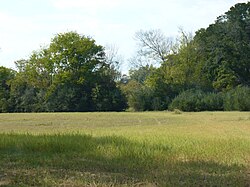Liddell Archeological Site
Appearance
Liddell Archeological Site | |
 The site in 2010 | |
| Nearest city | Camden, Alabama |
|---|---|
| NRHP reference No. | 78000511[1] |
| Added to NRHP | November 17, 1978 |
The Liddell Archeological Site is a prehistoric Native American site in Wilcox County, Alabama.[1] The site covers 50 acres (20 ha) and shows evidence of human occupation from 9000 BC to 1800 AD. It is best known for its Mississippian artifacts, primarily from the Burial Urn Culture period. The site was first documented in the 1960s, when the United States Army Corps of Engineers constructed Millers Ferry Lock and Dam on the Alabama River, creating the William "Bill" Dannelly Reservoir. The Liddell, Stroud, and Hall families donated the site to Auburn University after its discovery.[2] It was added to the National Register of Historic Places on November 17, 1978.[1]
References
[edit]Wikimedia Commons has media related to Liddell Archeological Site.
- ^ a b c "National Register Information System". National Register of Historic Places. National Park Service. April 15, 2008.
- ^ "Office of University Outreach Scholarship Grant Black Belt Environmental Science and Arts Program: 2005 Progress Report" (PDF). Auburn University. Archived from the original (PDF) on September 20, 2012. Retrieved October 14, 2008.
Categories:
- Auburn University
- South Appalachian Mississippian culture
- Archaeological sites in Alabama
- Archaeological sites on the National Register of Historic Places in Alabama
- National Register of Historic Places in Wilcox County, Alabama
- Native American history of Alabama
- Former populated places in Alabama
- Geography of Wilcox County, Alabama
- Alabama Registered Historic Place stubs
